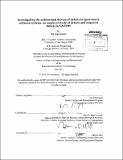Investigating the architectural drivers of defects in open-source software systems : an empirical study of defects and reopened defects in GNOME
Author(s)
Almossawi, Ali
DownloadFull printable version (12.60Mb)
Alternative title
Investigating the sources of defects in distributed open source software systems
Other Contributors
Massachusetts Institute of Technology. Engineering Systems Division.
Advisor
Alan D. MacCormack.
Terms of use
Metadata
Show full item recordAbstract
In major software systems that are developed by competent software engineers, the existence of defects in production is unlikely to be an acceptable situation. And yet, we find that in several such systems, defects remain a reality. Furthermore, the number of changes that are fixed only to then be reopened is noticeable. The implications of having defects in a system can be frustrating for all stakeholders, and when they require constant rework, they can lead to the problematic code-test-code-test mode of development. For management, such conditions can result in slipped schedules and an increase in development costs and for upper management and users, they can result in losing confidence in the product. This study looks at the drivers of defects in the mature open-source project GNOME and explores the relationship between the various drivers of these defects and software quality. Using defect-activity and source-code data for 32 systems over a period of eight years, the work presents a multiple regression model capable of explaining 16.2% of defects and a logistic regression model capable of explaining between 13.6% and 18.1% of reopened defects. The study also shows that although defects in general and reopened defects appear to move together, defects in general correlate with a measure of complexity that captures how components connect to each other whereas reopened defects correlate with a measure that captures the inner complexities of components, thereby suggesting that different types of defects are correlated with different forms of complexity.
Description
Thesis (S.M. in Engineering and Management)--Massachusetts Institute of Technology, Engineering Systems Division, System Design and Management Program, 2012. Cataloged from PDF version of thesis. Includes bibliographical references (p. 64-67).
Date issued
2012Department
System Design and Management Program.; Massachusetts Institute of Technology. Engineering Systems DivisionPublisher
Massachusetts Institute of Technology
Keywords
System Design and Management Program., Engineering Systems Division.